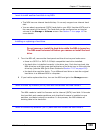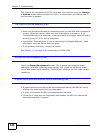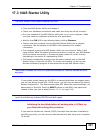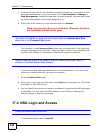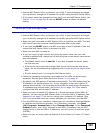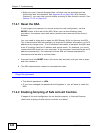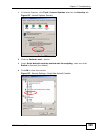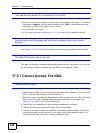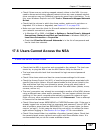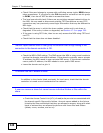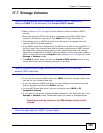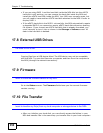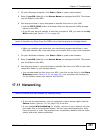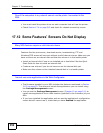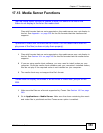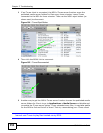
Chapter 17 Troubleshooting
NSA210 User’s Guide
347
• Check if there are any existing mapped network drives to the NSA. You may
need to disconnect existing mapped network drives as a new mapped network
drive connection may use (different) previously-saved login information. To do
this, open Windows Explorer and click Tools > Disconnect Mapped Network
Drives.
• Check that the volume in which the share resides, exists and is not down or
degraded. If it is down or degraded, see Section 17.2 on page 338.
• Make sure you have the client for Microsoft networks installed and enabled in
your network connection’s properties.
• In Windows XP or 2000, click Start > Settings > Control Panel > Network
Connections (Network and Dial-up Connections in Windows 2000/NT) >
Local Area Connection > Properties.
•Check that Client for Microsoft Networks is in the list of components and
has its check box selected.
17.6 Users Cannot Access the NSA
A local user cannot access a share
• Check that the NSA is turned on and connected to the network. The local user
should try to ping the NSA or use the NAS Starter Utility to discover it.
• The local user should check that he entered his login name and password
correctly.
• Check if the share exists and has the correct access settings for this user.
• Check the Access Control List (ACL) of read/write permissions associated with
specific files and/or folders. Account names added to the list are linked to the
files and folders that they are allowed to access, along with what kinds of
actions they are allowed to perform with those files and folders (delete, move,
rename, and so on).
• The user’s computer may already be connected to another of the NSA’s shares
using a different user name and/or password. This can happen without the user
realizing it if the user’s computer automatically connects to a share at logon.
Right-click any other connected shares and click Disconnect. Then re-attempt
to connect to the desired share.
• Check if the share has an ANONYMOUS or EVERYONE access right. If the user is
already logged into a share using her username and password, she will NOT be
able to access a share that has ANONYMOUS FTP only access rights (as these
require ‘no login’). In this case she should log out and try to access the share
again without logging in. See Section 9.4 on page 167 for more details.
• Check if the shared folder is a subfolder of another (parent) share. Check that
the parent share’s access rights do not conflict with the subfolder share. It is
recommended that you do not create subfolder shares.



